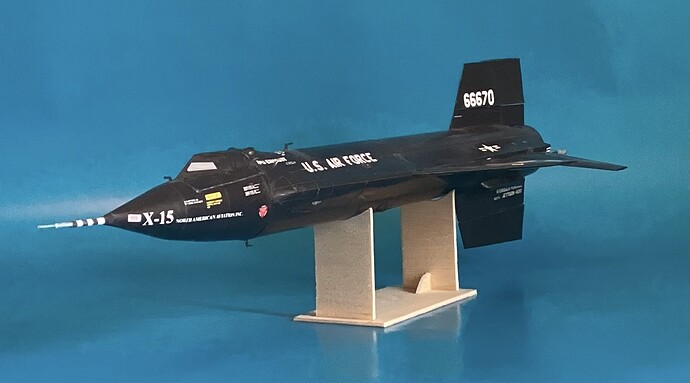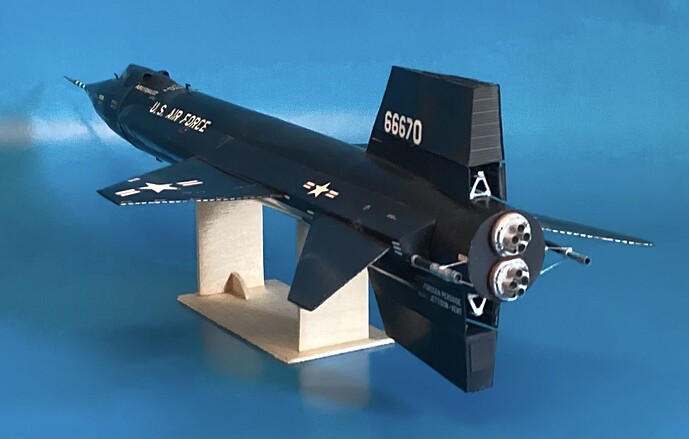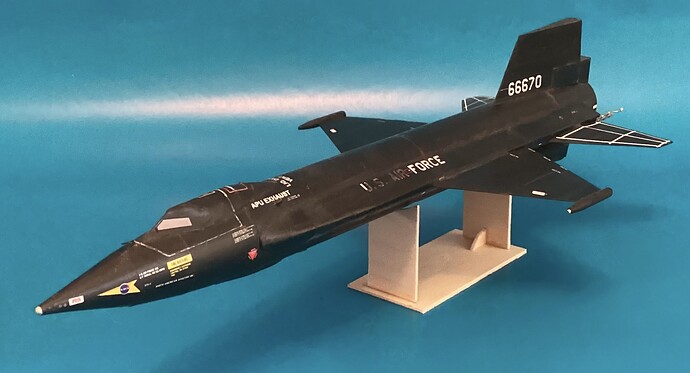Here are a couple more card X-15s in 1/48th, but there’s a theme: the first and last flights of X-15-1, 66670. The first couple of photos are of 66670 as it appeared on its first powered flight on 23 January 1960, Flight 1-2-7. (Although 66670 made its first glide flight on 8 June 1959, the first powered flight in the X-15 program was actually by X-15-2, 66671, on 17 September 1959.)
On its first flight, 66670 was clean and unweathered. The airframe was painted a semi-gloss black with a slight blue tint. It only took a supersonic flight or two to bake off the paint and give the X-15 a weathered look. The alloy used for the fuselage, Inconel X, is silver but turns a blue-black color after a little heating from atmospheric friction.
I scratchbuilt the LR11 rocket motor and I also did some scratchbuilding on the vertical stabilizers, cutting each into separate sections and building each as its stub and moveable rudder section.
Today, 66670 hangs proudly in the Smithsonian’s National Air and Space Museum. After its last flight on 24 October 1968 (the 199th and last flight of the X-15 program) the vehicle was placed in storage but later moved to the NASM.
Hanging from the ceiling of the NASM, 66670 carries what could be considered the “generic” colorful X-15 markings: National insignia and “USAF” markings on the wings; national insignia on the rear fuselage and “U.S. AIR FORCE” on the side tunnels; yellow NASA bands and “66670” on the vertical stabilizer.
But that isn’t how 66670 looked on its last flight. On Flight 1-81-141, 66670 carried only the serial number on the tail and the “U.S. AIR FORCE” legend on the side tunnels — and it was pretty much burned off by heat on the left tunnel. ) It also had white stripes (perhaps camera markings) on the upper surface of both tailplanes. It carried the Phase II Photometer in an experiment box behind the vertical stabilizer and was fitted with the wingtip experiment/sensor pods.
This one took awhile to research. By this point in the X-15 program, there was very little photo coverage of the flights. I contacted Michelle Evans, author of, “The X-15 Rocket Plane: Flying the First Wings into Space,” to see if she had any photos or information, and she was very helpful, digging up a couple of the only known photos from the final flight and immediately afterwards.
I scratchbuilt the LR99 rocket motor and the Phase II Photometer and wingtip pods and jettison tubes.
And yeah, for those with OCD, NASA made eight attempts to fly a 200th flight. All ended in aborts either before takeoff or once airborne. The final attempt was 20 December 1968, but while the B-52 carrier plane was getting ready to taxi, Edwards AFB was enveloped in a snowstorm, of all things. The mission was cancelled. Funding for the X-15 program ran out at the end of the year. By the following June, 66670 — repainted by NASA — was at the Smithsonian.



